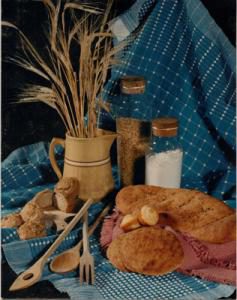Whole grain barley is nutrient rich.

Looking to increase your intake of whole grains? Barley may be just the grain you have been looking for. Whole grain barley is nutrient-rich, containing high amounts of antioxidants, vitamins, minerals, as well as being an excellent source of dietary fiber. According to the USDA Nutrient Database, one serving of whole grain barley (1/4 cup uncooked) provides 163 calories, 6 grams of protein, 34 grams of carbohydrate, one gram of fat, and 8 grams of fiber. Among all the whole cereal grains, barley contains the most fiber.
Typically, fiber is located in the outer bran layer of most cereal grains. However, the fiber content in barley is found all the way through the whole grain which contributes to its high fiber content. Click here to visit the Oldways Whole Grains Council for more information on the health benefits of whole barley, basic tips on how to cook whole grains, and recipe ideas.
Most barley has a tough indigestible hull that tightly surrounds the kernel. This hull must be removed before eating. The fastest method to eliminate the hull is to scrape (pearl), which also removes most of the outer bran. The final product is called pearl barley or quick pearl barley which is not a whole grain.
Choose whole grain barley products by selecting hulled or hulless barley. Hulled barley is minimally processed by carefully removing the indigestible hull while leaving much of the outer bran intact. Hulless barley is a different variety of barley that does not have a tightly-attached hull and is easier to remove with minimum bran loss.
Choose Whole Grain Barley – Not Refined Pearl Barley
Grains are available in two forms: whole and refined. Whole grains are the least processed and contain the whole kernel – the bran (fiber), germ, and endosperm. They are excellent sources of dietary fiber, vitamins, and minerals. A few examples of whole grains are hulled or hulless barley, brown rice, bulgur (cracked wheat), oatmeal, whole cornmeal, and whole wheat flour. Refined grains have been milled. Milling is a process that separates the three parts of the kernel, removing the bran and germ, leaving only the endosperm.
While there are many food production benefits to milling, including increased shelf life, the disadvantages are the removal of important and essential nutrients including fiber, iron, and several B vitamins. A few examples of refined grains are pearl barley and quick pearl barley, de-germed cornmeal, white bread, white flour, and white rice. Even though most refined grains are enriched, which is the process of replacing lost nutrients during processing such as B vitamins and iron, the fiber is not replaced.

Whole grain barley can be eaten whole or made into other whole grain products including barley grits, barley flakes, and barley flour. The refined form of barley, pearl barley or quick pearl barley, can also be used to make barley grits, barley flakes, and barley flour. However, those products are not whole grain. Read the food label to choose whole grain barley products.
The whole grain barley food label should read either whole, hulled, or hulless barley. Food labels that read pearl or quick pearl barley are refined.
Note: Barley contains gluten.
Click here to visit the OldWays Whole Grains Council for pictures and descriptions of the different forms of barley: hulled, hullless, grits, flakes, flour, pearl, and quick pearl.
 10
10
